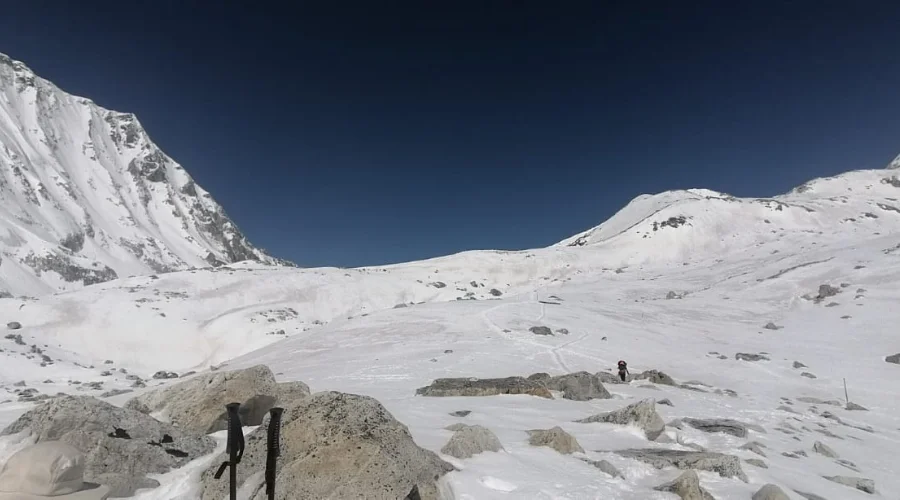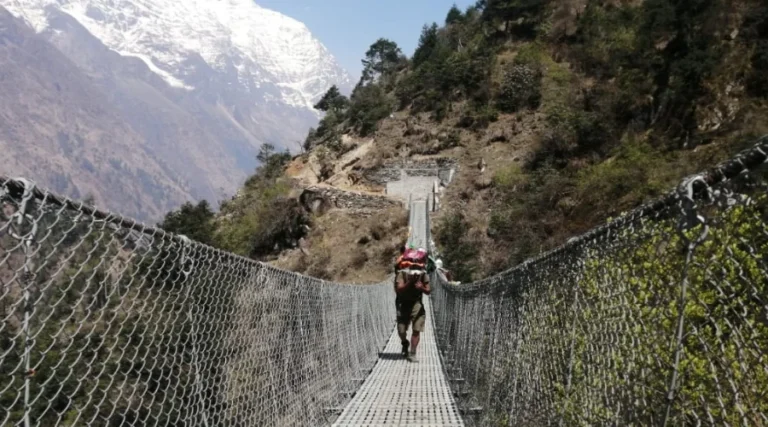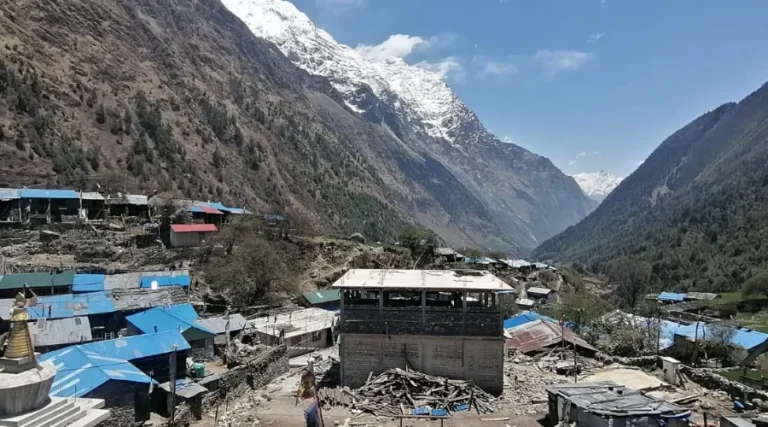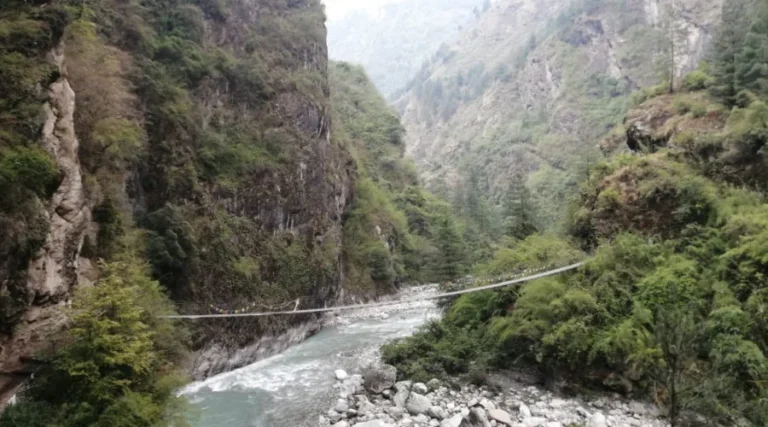Manaslu Circuit Trek
-

Trip Duration 16 Days
-

Max, Altitude 5106 meters
-

Type Standard
-

Best Season Sept - May
-

Meals Included
-

Accommodation Guest House
-

Activity Trekking
-

Difficulty Strenuous
- Watching a beautiful view of Mount Manaslu (8,163m) and other spectacular views of the Himalayan range as it goes on the trail.
- Magnificent Larkya La Pass -5,106 m high with a stunning panorama of snow landscapes.
- The generous nature of the Gurung and Tibetan people will touch visitors to the traditional villages of Samagaon and Samdo.
- Trekking in this forest country and seeing a wide variety of wild fauna, such as snow leopards, Himalayan tahr, and red pandas, in this national park.
- Walk through ancient Buddhist monasteries like Pungyen Gompa and be amazed by the prayer wheels, mani walls, and colourful curtains that line the paths.
- Take a quiet, meditative trekking experience, not on the heavily travelled Annapurna or Everest trails.
- Walk across heterogeneous landscapes, from terraced fields and river valleys to alpine meadows and high-altitude glaciers.
- Go on an adventure trek that combines adrenaline, nature, and culture. It is perfect for visitors looking for a truly memorable trip to the Himalayas.
The Manaslu Circuit Trek is a fine adventure in Nepal. It surrounds the highest mountain peak, Manaslu. This trail is ideal for people who enjoy nature and peaceful paths. It offers magnificent scenery of snow-covered mountainscapes, woods, and still waters.
Overview of Manaslu Circuit Trek
In this Manaslu Circuit Trek, the itinerary passes through notable, peaceful little towns where one can meet its familiar locals and experience their ancient memories of neighbourhood culture.
Manaslu Circuit trail is full of thrills and fabulous views. You’ll pass through the Manaslu Conservation Area, home to rare animals like snow leopards and red pandas. The trekker’s primary attraction is Larkya La Pass, a very high alpine and high altitude pass with beautiful scenery.
The Manaslu Circuit Trek is the ideal adventure, culture, and nature trek. It’s a peaceful and satisfying experience that will remain with you. Whether it be the great mountains, the beautiful character of the local people, or the feeling of accomplishment, this trek is indelible.
This is the trek if you’re looking for a unique and meaningful journey in Nepal.
What makes Manaslu Circuit Trek unique among other popular trekking trails?
Manaslu Circuit Trek is one of the most developing treks in Nepal. People worldwide prefer this trek to the Everest Base Camp Trek or Annapurna Circuit Trek. But do you know the reason behind it? If not, then have a look in detail below:
1. Less Crowded and Peaceful Trails
Unlike Everest’s more densely populated locations or the Annapurna region, the Manaslu Circuit offers considerably less crowded treks.
It perfectly suits every walker and daydreamer who seeks nature, calmness, and privacy and wants to discover and sense nature and the environment.
2. Unspoiled Natural Beauty
The Manaslu area is very popular due to its natural and wild scenery. The route passes through the following scenes: forest and waterfalls, terraced fields, glacial rivers, and high mountains and passes.
Among the most stunning is the Larkya La Pass (5,106 m), which gives a spectacular view of Mount Manaslu, one of the world’s eight highest peaks.
3. Rich Cultural Experience
While on the trail, you can enjoy the unique spirit of the Tibetan local houses. The local communities, namely the Gurung and Tibetan ethnic groups, carry on their traditions through their temples and traditions.
Festivals, which present a fascinating journey into cultural experience. For instance, villages such as Sama Gaun or Samdo are historically rich.
4. Adventure and Challenge
The Manaslu Circuit Trek is claimed to be moderately complex, making it a suitable adventurous tourist destination. Because of its high altitude, challenging terrain, and remote location, it is a real wild-place experience.
5. Restricted Area and Permit System
The trail is in a managed area; therefore, a special permit accompanied by a trained guide is required. This favours recruiting a limited number of trekkers while maintaining the pristine nature and cultural identity.
6. Affordable Compared to Everest and Annapurna
Although an adventure tour, the Manaslu Circuit Trek is far less expensive than the Everest Base Camp Trek (i.e. Food and lodging, as well as permits, are cheap, therefore a budget option in a trek for budget travellers.
7. Close Views of Mount Manaslu
The trekking’s centrepiece is Mount Manaslu (8,163 m), and the exceptional, almost immersive views afforded in this trek make it truly memorable.

On the other hand, Hiking provides the opportunity to engage in activities other than the market related to the experience of the mountains in the Annapurna or Everest hill area.
8. Diverse Flora and Fauna
The trail enters the Manaslu Conservation Area, where many species live, including Tibetan ibex, snow leopard, and red panda. Naturalists will enjoy the rich biodiversity and beautiful scenery.
Short Itinerary
Itinerary of Manaslu Circuit Trek
Once you arrive outside the terminal of Tribhuvan International Airport, you will be picked up by our representative who will drop you off at the hotel. Overnight in Kathmandu.
After breakfast, you will be taken on a guided tour to the most spiritual and popular attractions in Kathmandu. Some of these attractions are even included in the list of World Heritage Sites. Witness the brilliant Kathmandu Durbar Square, the holy Hindu temple of Pashupatinath, the renowned ‘Monkey Temple’ (Swayambhunath), and one of the largest stupas in the world-Bouddhanath. Overnight in Kathmandu.
Prepare for the journey as we drive from Kathmandu to Machha Khola, your trek’s starting point. Experience the shift from city to village life as we head towards rugged trails. This is where your adventure begins.
Cross dense forests, cascading waterfalls, and fascinating rock formations as you make your way to Jagat, a charming village enriched with Tibetan culture.
Experience changing landscapes as you ascend towards Deng. Pass through quaint villages and terraced fields. Dive in the serene surroundings.
Journey through pine forests and scenic landscapes, arriving in Namrung. A place where stunning views of Siringi Himal and Ganesh Himal welcome you.
The day start walking with exploring Tibet-influenced typical lifestyle, you will walk past several mani walls, lush terraces, and houses through Banjam to enter the fir, rhododendron, and oak forest before climbing to Lihi and then to Sho.
As you go further, you will notice some fine paintings in the Kani (gate arches) that you pass before Sho. Walking across the rocky hillside routes, you will finally reach Lho.
From Lho, you can catch stunning views of Manaslu (8163m) and Manaslu North (7157m). On this day, you will gain a high altitude, so you must walk slowly and check your body signs.
We make our way from Namrung through a scenic trail with magnificent views of mighty Himalayan giants like Dwijen Himal, Saula Himal, Manaslu Mountain, Rupinala pass, Lajing peak. We also pass through beautiful monasteries as we make our way towards the Lho village. Overnight at Lho.
Today, we explore the surrounding areas of Samagoan for acclimatization. We get to learn about the Sherpa lifestyle and culture while enjoying the sight of thousands of mani stones with Buddhist texts. We make a visit to the PungyenGompa, an ancient monastery. There we can enjoy great views of the glacier. Overnight in Samagaon.
Today, we leave Samagaon and head for Samdo. We first descend to the Budi Gandaki River. We move through the valley to reach Samdo. The village offers beautiful views of Manaslu, Samdo, Nagdichuli and Manaslu glacier. Stay overnight in camp. Overnight in Samdo.
Today, we rest and acclimatize. We will also explore areas surrounding Samdo. We get to choose between two options – Hike up to a valley directly up Samdo and back or take a trip to Gya La. We recommend the first option. The hike leads us to one of the trade passes to Tibet where marvelous views of Mt. Manaslu along with other Himalayan ranges including Simran, Hiunchuli, Ngadi, Larkye Peak, Cheo can be seen. We also can spot the Lophophorus, Lammergeyer and Himalayan Griffin en route. The other option of hiking to the Gya La, a more regularly used trading route to Tibet, is longer and can be exhausting. Overnight in Samdo.
We descend from Samdo village, cross a bridge over the Budi Gandaki and climb upwards while enjoying views of the Larkya Glacier. We make our way around the valley and then climb up towards Dharmasala. Overnight in Dharmasala.
We set off early from Dharmashala towards the base of Larkya La Pass. After an arduous climb, we reach to the summit of Larkya La Pass. The summit offers extraordinary views ofHimlung Mountain, Annapurna II Mountain, Kangurung and Cheo Mountain. From the summit, we descend towards Bhimtang where spectacular views of Manaslu and Lamjung Mountains await us.
After a good breakfast, we move down towards the Surke River. We then ascent on a trail through pine forest, to reach the Dudhkoshi River. We move further moving in and out of Dharapani, passing through Gho village to ultimately reach the Tilje village then continue walking to Dharapani. Overnight in Dharapani.
Breakfast and take a local jeep to Besisahar. We cross the Marshyangdi Khola following the trail to Chyamje. We soon find ourselves descending through rhododendron and pine forests to reach Besisahar. From Besishar drive back to Kathmandu. Overnight in Kathmandu.
This is it, your last day in Nepal. It’s time to say goodbye, but we hope we’ll meet again! Our representative will escort you to the airport.
 Price Info
Price Info
The prices may vary depending upon date of travel, Category of hotels, Group size, Surge Pricing and seasonal rush. So you are kindly mention detail in inquiry form so our team will work out for the best possible price.
Price includes
- All the transportation between airport and hotel
- 3 nights in a 3- star hotel in Kathmandu with breakfast
- Local Transportation to Machha Khola and from Dharapni to Kathmandu
- 14 nights in standard lodges/teahouses during the trek
- Sightseeing in Kathmandu inclusive of Entrance fees, guide and car
- Welcome and farewell dinners
- All accommodation and meals during the stay in the trek
- An experienced English speaking guide and one porter for 2 persons each of the group
- All necessary paper work and permits (National park permit, TIMS)
- All government and local taxes
Price Excludes
- Nepal Visa fee (bring accurate USD cash and two passport photographs)
- International airfare to and from Kathmandu
- Excess baggage charges
- Extra night accommodation in Kathmandu and Pokhara because of early arrival, late departure, early return from mountain (due to any reason) than the scheduled itinerary
- Lunch and evening meals in Kathmandu (and also in the case of early return from mountain than the scheduled itinerary)
- Travel and rescue insurance
- Personal expenses (phone calls, laundry, bar bills, battery recharge, extra porters, bottle or boiled water, shower etc)
- Tips for guides and porters
Have any Questions? Check out FAQ'S
Trip Essential Information
Altitude Sickness During the Manaslu Circuit Trek
Altitude sickness (i.e., acute mountain sickness (AMS) is a natural event at the altitude of the Manaslu Circuit Trek and, in particular, on the ascend to higher elevations.
This trek is to wild, high-altitude regions. The summit is the Larkya La Pass, which is 5,106 m (16,752 ft) high.
Knowledge of risk zones and avoiding acute mountain sickness (AMS) have excellent operational value in ensuring safe and pleasurable trekking.
High-Risk Areas for Altitude Sickness
Case of higher incidence of altitude sickness, usually above 3,000 m (9,842 ft). In the Manaslu Circuit Trek, villages such as Sama Gaun (3 520 m) and Samdo (3 875 m) are often reported locations where symptoms are initially manifested.
The most sensitive area is at/near Larkya La Pass, where it is required to pass over high-altitude areas with atmospheric low pressure and subzero temperature. And because of long-distance walking on this day, symptoms may resolve worse.
To prevent these issues, acclimatization is paramount–the Sama Gaun one day of rest before each elevation above the base level is an example. Climb carefully, and do not ascend more than 500 m (1,640 ft) daily.
Best Time for the Manaslu Circuit Trek
The best times to go on a Manaslu Circuit Trek are spring (March to May) and autumn (September to November). These are the best seasons for trekking, with the best weather, clearest skies, and stunning mountain and surrounding views.
Spring (March to May)
A wonderful thing about walking the Manaslu Circuit is the spring temperatures, and the walk itself is lined with green and flowering rhododendrons.
The weather is pleasant, with temperatures between 10 and 20 °C from the site’s foundation up to higher degrees. Visibility is excellent, and one can enjoy fantastic views of mountain ranges like Manaslu, Himalchuli, Ganesh Himal, and more.
This spring is perfect for hikers who want to see poppies on the trail. However, it is also a hectic period of the year, so deeper trekkers and bustling tea houses will likely be present.
Autumn (September to November)
The Manaslu Circuit Trek is the most popular season of the year in autumn. Yet, when the monsoon rains stop, the air turns cool and dustless, bringing a clear horizon toward the mountain ranges behind.
Daytime temperatures are not strongly warming, ranging from 10 to 15 degrees Celsius, and they cool down in the evening and at higher elevations.
A prepared trekker can make it happen this season in favourable weather and conditions in quiet areas. Trekking is also evident during this period, reflecting the role of local community members in celebrating the Dashain and Tihar festivals.
Off-Season Manaslu Trekking
Winter (December to February):
Hikes are possible and intense in high, steep temperatures, heavy snow, and trail closure. Winter treks on this path should only be undertaken by highly experienced walkers with relevant equipment.
Monsoon (June to August):
Tracks are muddy and highly susceptible to landslides, and leaches are problematic. However, the air is still due to the land being very compact, and the concentration of people is, in fact, not high.
Manaslu Circuit Trek Difficulty
The Manaslu Circuit Trek Difficulty is known to be one of the most demanding trail routes in Nepal. The route involves a variety of undulating topography across the landscape, including gentle, leafy slopes, hard stones and steps, and exposed terracing at high altitudes.
It is physically and mentally demanding, with required proper preparation as it is pretty far away from any facilities, and any changes would occur based on the environment in which the trial is conducted, the road, or the traditional setting.
Factors Contributing to the Manaslu Difficulty
1. Altitude and High Pass Crossing
One of the biggest challenges is the high altitude. The climb culminates at the Larkya La Pass, 5,106 m (16,752 ft). There is also less oxygen at this altitude so that breathing can be challenging.
2. Long Walking Hours
The trek is typically 14-18 days long, and the activity on each day is 6-8 hours with hiking time. For instance, climbs to Larkya La Pass may take up to 10 hours.
The paths are generally steep, rocky and/or narrow and must be navigated carefully and with high physical capability.
3. Remote and Basic Facilities
The Manaslu region is remote and has limited infrastructure. Throughout the trail, tea houses offer some shelter and food.
However, they may not provide the amenities that well-established routes, such as Annapurna or Everest, generally offer hikers.
4. Unpredictable Weather
Weather conditions in the Manaslu region can change rapidly. You may get caught in the rain, snow, or a strong wind (especially at high altitudes).
In wintertime, the trails can be very hazardous under a skinny layer of frosty glaze, introducing the risk of slipping and stumbling. Trekkers need appropriate trekking clothing in layers, as well as sturdy footwear to manage such weather events.
Who Can Complete the Trek?
The route is appropriate for those with strong trekking experience or excellent fitness. Even novices can try it, but some degree of prior preparation, including shorter treks or regular aerobic training, is strongly advised.
Tips to Overcome Challenges Manaslu Trekking
- Train Before the Trek: Prepare with cardio, strength training, and long walks for endurance
- Acclimatize Properly: At rest, acclimatize to high altitudes and do not increase altitudes abruptly.
- Carry Essential Gear: Buy top-quality trekking boots, warm clothing, and a heavy pack.
- Hire a Guide: A local guide can ensure safety, facilitate acclimatization, and provide information on local culture and history.
- Plan for the Season: Trek in spring (March to May) or autumn (September to November), when the weather is favourable.
Accommodation in Manaslu Trek Nepal
Tea houses represent the only type of accommodation in the Manaslu Trek Nepal, and these are small, locally run lodges that line the trekking way. These tea houses offer basic facilities to trekking people, such as bedding, food, and, in some cases, basic facilities.
Rooms are typically small and convertible, with twin beds, thin mattresses, pillows, and blankets. Because of the remote location, the standard of facilities drops with an increase in altitude. Warm sleeping bags should be kept in good condition, especially on cold nights.
In smaller villages such as Soti Khola and Machha Khola, the teahouses have more equipment, private rooms, private baths and a more extensive menu. One way amenities can be increased relates to the direction of altitude with, e.g., Sama Gaun and Samdo, where they are minimal.
Shared toilets and limited food options are standard. Hot water and charging functionalities are usually provided at a cost premium. Electricity, in many cases, is solar-powered, so it is a good idea to carry a power bank for your electronic devices.
During the high season (spring and autumn), visitors to tea houses are likely to be in large numbers, so it is recommended to pre-book or travel with a local guide when available.
Through appropriate planning and flexibility, a comfortable stay is possible. At the same time, tourists can observe the beautiful nature, life, and culture of the Manaslu area.
Food in Manaslu Trekking Nepal
Food is generally provided at the Manaslu Trekking Nepal trail tea houses. The basic, rich fare is meant to power through the trek. The menu usually consists of Nepali, Tibetan, and some Western cuisine, and there is a selection of dishes to cater to varied needs.
Dal Bhat is the local main dish. It is a traditional Nepali fare of cooked rice and soup made of lentils, seasonal greens, and pickles. This meal is very nutritious and served in unlimited quantities in most tea houses; hence, it is a favourite among trekkers.
For instance, traditional local foods include Thukpa (a Tibetan noodle soup) and Gundruk (a fermented leafy green vegetable soup). Steamed or deep-fried dumplings stuffed with vegetables and/or meat are also delicious.
The trekkers may select pancakes, porridge, boiled eggs, or Tibetan bread with honey and/or jam for breakfast. Western food, such as pasta, fried rice, and potatoes, may also commonly be found.
Remoteness and transportation difficulties make Food selection easier at high altitudes. The price increases as you reach for the sky because porters or yaks must lift goods.
Tea plus hot drinks, such as ginger or butter tea, are of primary significance in keeping warm when it is cold out. Drinking enough fluids to keep them hydrated and prevent altitude sickness is useful.
Drinking Water during the Manaslu Circuit
Safe access to drinking water is crucial when trekking the Manaslu Circuit. Staying hydrated is vital for avoiding altitude sickness and remaining energetic.
You will have enough trail water; however, it is also essential to purify and clean the water, which must be free of impurities and safe for consumption.
One can refill the bottles with drinking water, which is available in the local tea houses, where boiled water is usually provided at a cheap price. Boiling provides freedom from potentially pathogenic microorganisms and, thus, is one of the safest choices.
Packed bottled water is also available in tea shops and at the trailheads; however, the water becomes progressively more expensive as you go higher.
WIFI, Internet and Electricity in Manaslu Trek Nepal
WiFi, internet, and electricity are partially available on the Manaslu Trek in Nepal, although the area’s remoteness limits them. Trekking groups should be prepared for intermittent connectivity, and charging points should be limited on the trail.
Wi-Fi and Internet
Access to Wi-Fi is generally available in many tea houses in the lower villages (e.g., Soti Khola, Machha Khola). However, the web connection can be unreliable and inadequate. WiFi networks are even more scarce at higher altitude sites like Samdo or Sama Gaun.
Wi-Fi generally has a slow speed, sometimes deteriorating due to weather and high demand. Most teahouses offer Wi-Fi at a nominal cost up to a certain altitude but upward goes beyond that.
Trekkers can buy a local SIM (e.g., Ncell or Nepal Telecom) offering a 3G or 4G internet service for more stable connectivity. However, the signal level varies along the path, with increased coverage at lower sites and insufficient or no coverage at higher sites.
Electricity
Recharging electronic gadgets such as cell phones, cameras, or power banks is feasible, although tea houses usually charge customers a fee.
Electricity generation costs increase with altitude due to insufficient equipment transportation and inadequate power supply.
Carry a power bank or a solar charger to ensure your devices stay charged. Minimizing device use and switching to low-consumption modes can help conserve battery energy.
Tips for Staying Connected and Powered
1. Plan for Limited Access: Before commencing the trek, trekkers must inform their friends and family of potential connectivity difficulties.
2. Carry Backups: Take power banks or solar chargers to keep your electronic devices functional.
3. Use Energy Wisely: Conserve battery life by minimizing unnecessary apps and capabilities.
4. Invest in SIM Cards: It has been proposed that a local SIM card be purchased for better local coverage at lower elevations.
Should I Hire a Porter During the Manaslu Circuit Trek?
Most notably, using a porter on the Manaslu Circuit Trek is highly recommended if you are heavily laden with items or a newcomer to high-altitude trekking.
The hike consists of hours of walking, steep ascent, and rough routes that may be very physically strenuous. A porter can release your load by removing your backpack, freeing you to think only of this walk and conserve energy.
Porters are highly skilled at traversing the terrain and can carry up to 15–20 kg of baggage. Their assistance is invaluable for ensuring a comfortable and less stressful trekking experience.
Employing a guide and a porter is advisable when travelling in a group. Although the guide guarantees your safety and wayfinding, the porter carries the weight, making travel easier.
Trekkers should respect porters, equip them sufficiently for the trek, and not overload them.
ATMs on the Manaslu Circuit Trek
ATMs are absent on the Manaslu Circuit Trek once you leave the trailhead, which most commonly is found to be Soti Khola and Arughat.
It is crucial to withdraw sufficient cash in Kathmandu or Pokhara before starting the trial, as one needs money for food, overnight stays, and payments for internet, power, etc., during the trial.
Tea shops and establishments along the trail only take cash (usually Nepali rupees). Since so planning your budget and having enough money is advisable to avoid financial discomfort.
Packing Essentials for Manaslu Circuit Trek
When gearing up for the Manaslu Circuit Trek in Nepal, it’s key to pack light and ensure you have all the essentials for a comfortable and safe journey through the remote Himalayas.
Clothing
- Layering Clothing: Lightweight, moisture-wicking base layers, insulating mid-layers, and a waterproof, windproof outer layer are essential.
- Insulated Jacket: A warm-down or synthetic jacket for colder temperatures at higher altitudes.
- Trekking Pants: quick-drying and comfortable pants suitable for various terrains
- Hiking Boots: Sturdy, well-broken-in boots with good ankle support.
- Socks: Several moisture-wicking and cushioned socks are recommended to prevent blisters.
Gear
- Backpack: A comfortable and durable backpack with proper support and capacity to carry essentials
- Sleeping Bag: A quality, warm sleeping bag suitable for lower temperatures encountered on the trek
- Trekking Poles: Adjustable and sturdy poles to stabilise and reduce joint strain during ascents and descents.
- Headlamp/Flashlight: Essential for navigating in the dark or inside lodges with limited lighting.
- Water Purification: Use water purification tablets or a reliable filter for safe drinking water.
Miscellaneous Items
- First Aid Kit: Including essential medications, bandages, blister treatments, and altitude sickness medication.
- Sun Protection: sunglasses, sunscreen with a high SPF, and a wide-brimmed hat.
- Personal hygiene: wet wipes, hand sanitizer, and toiletries in travel-sized containers.
- Electronics: portable charger, camera, and spare batteries.
- Trekking Map/Guidebook: Useful for navigation and understanding the route.
Permits for Manaslu Circuit Trek
Ensure you have the Manaslu Restricted Area Permit (RAP), the Annapurna Conservation Area Permit (ACAP), and the Manaslu Conservation Area Permit (MCAP), as well as other required permits.
When packing for the Manaslu Circuit Trek, consider the weather and terrain you will encounter. Choose lightweight, versatile items that can handle various conditions to keep your backpack manageable. This will help you stay prepared for whatever comes your way on the trek.
Frequently Asked Questions (FAQ)
The Manaslu Circuit trek covers a distance of approximately 177 kilometers (110 miles) in total. It usually takes around 15 days to complete, including both the ascent and descent, with each day offering new landscapes and cultural experiences.
The Manaslu Circuit trek is considered challenging. The trail involves varying terrain, high-altitude sections, steep ascents and descents, and crossing the Larkya La Pass at an altitude of 5,160 meters. Prior trekking experience and a good level of fitness are recommended to fully enjoy this trek.
The cost of the Manaslu Circuit trek package can vary depending on various factors, such as the duration of the trek, the type of accommodation, and additional services. On average, the cost can range from $1200 to $1800 USD per person. This typically includes trekking permits, accommodations, meals, transportation to and from the trailhead, and the services of experienced guides and porters.
The 15-day Manaslu Circuit trek is an amazing journey that takes you around the majestic Manaslu peak in Nepal. This trek covers approximately 177 kilometers and includes breathtaking landscapes, encounters with local cultures, understanding their way of life in such remote places on earth, and the exhilarating experience of crossing the challenging Larkya La Pass.
Yes, there are teahouses and lodges available in most villages along the Manaslu Circuit Trek. However, the infrastructure is less developed compared to the popular Everest and Annapurna regions.
Preparing for the Manaslu Circuit Trek requires a mix of physical readiness, mental preparation, and proper gear. Stay active with cardio, strength training, and hiking to boost endurance. Keep a positive mindset for tough terrain and high altitudes. Follow the itinerary with acclimatization days, which is very essential! Pack key gear: layers, sturdy boots, a comfy backpack, a warm sleeping bag, trekking poles, and personal first aid. Learn about altitude sickness and its signs. Train for altitude hikes, and ensure insurance covers trekking. Respect local customs and have an experienced travel partner (guide) along with you. With these preparations, you’re set for the unforgettable Manaslu Circuit adventure.
To enjoy the Manaslu Circuit trek safely, having the right gear is essential. Begin with suitable clothing. Sturdy boots with ankle support are yet another important thing to pack, along with extra socks. A comfortable backpack with hip and chest straps evenly distributes weight.
Carry a warm sleeping bag for higher altitudes. Also consider using trekking poles for steep sections. A headlamp is useful in low light. Bring a personal first aid kit with medications and blister care, and ensure you can purify water for drinking.
Remember sun protection: sunscreen, lip balm, sunglasses, and a wide-brimmed hat. Also, don’t forget permits, Nepali currency, and a camera. With these essentials, you’re set for an amazing Manaslu Circuit adventure.
The Manaslu Circuit Trek starting from Soti Khola which is height of 710meters and 2328feet and the trail follows an ancient salt-trading route along the Budhi Gandaki River The highest point reached along the trek route is Larkya La at an elevation of 5,106 metres (16,752 ft) which is the highest point of Manaslu Circuit Trek.
The Manaslu Circuit trek is a perfect adventure in Nepal, spanning 12 to 18 days, with a common itinerary lasting around 14 days. Trekkers should prepare physically and mentally through regular aerobic exercises.
You also need essential permits including the Manaslu Conservation Area Permit and the Restricted Area Permit. These can be arranged through us at Himalayan Trekking. A well-thought-out packing list should include waterproof clothing, insulating layers, a good-quality backpack, and personal essentials.
The Manaslu Circuit Trek is generally harder than the Everest Base Camp trek. It has rougher terrain, longer daily hikes, and higher altitude passes. It requires trekkers to walk for 5 to 8 hours each day. In contrast, the Everest Base Camp trek has more established trails and facilities, making it more accessible for many trekkers. Overall, the Manaslu Circuit’s remote and challenging nature makes it a tougher option.
© 2026 - Himalayan Trekking and Tours (P) Ltd. All Rights Reserved.











 Price Info
Price Info

